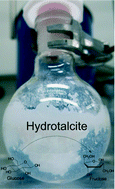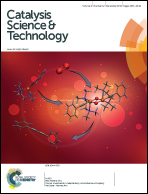Catalytic activity and stability of hydrophobic Mg–Al hydrotalcites in the continuous aqueous-phase isomerization of glucose into fructose†
Abstract
The aqueous-phase isomerization of glucose into fructose, catalyzed by Mg–Al hydrotalcites, has been investigated under batch and continuous conditions. A commercial hydrotalcite with a hydrophobic surface modification and two hydrophilic hydrotalcites in carbonate form, or with OH− anions in the interlayer space, served as catalysts. With the hydrophobic hydrotalcite a lower conversion but superior selectivity to fructose could be demonstrated, reaching above 92% selectivity at 30% conversion. The observed by-products confirm retroaldolization of glucose and fructose as the main side reactions causing catalyst deactivation via adsorption. Additionally, acidic degradation products such as lactic acid cause neutralization of the hydrotalcites facilitating leaching of the Mg2+ ions. Fructose contributes a greater extent to by-product formation. Applying continuous operation conditions, fructose is removed from the reaction mixture. Therefore, by-product formation is notably suppressed and catalyst stability increases. During 70 to 100 h time-on-stream a slow deactivation of the hydrophobic hydrotalcite occurs. Regeneration can be achieved via calcination and treatment in an aqueous sodium n-dodecyl sulfate solution to introduce dodecyl sulfate anions to the interlayer space of the hydrotalcite, restoring the hydrophobic material properties.

- This article is part of the themed collection: Porous Materials (FEZA 2014)

 Please wait while we load your content...
Please wait while we load your content...